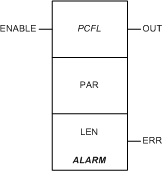|
|
(Original Document)
|
|
Name in LL984 Editor
|
Function Block Name
|
|---|---|
|
name of legacy 984 instruction
|
name in other tools and editors like:
|
 |
 |

|
Input Pin
|
Name
|
Data Type
|
Address Range
|
Meaning
|
|---|---|---|---|---|
|
Top
|
ENABLE
|
–
|
ON = enables process control function
|
|
Node
|
Node Type
|
Name
|
Data Type
|
Address Range
|
Meaning
|
|---|---|---|---|---|---|
|
Middle
|
IN/OUT
|
PAR
|
ARRAY[1...16] OF UINT
|
%MW
|
see Parameter PAR below
|
|
Bottom
|
IN
|
LEN
|
UINT
|
16
|
length of parameter block (can not be changed)
|
|
Output Pin
|
Name
|
Data Type
|
Address Range
|
Meaning
|
|---|---|---|---|---|
|
Top
|
OUT
|
BOOL
|
–
|
ON = operation successful
|
|
Bottom
|
ERR
|
BOOL
|
–
|
ON = operation not successful
|
|
Word
|
Content
|
Format
|
|---|---|---|
|
1, 2
|
input value
|
REAL (Floating Point)
|
|
3
|
output status
|
UINT
|
|
4
|
input status
|
UINT
|
|
5, 6
|
high high limit value
|
REAL (Floating Point)
|
|
7, 8
|
high limit value
|
REAL (Floating Point)
|
|
9, 10
|
low limit value
|
REAL (Floating Point)
|
|
11, 12
|
low low limit value
|
REAL (Floating Point)
|
|
13, 14
|
deadband (DB) around limit
|
REAL (Floating Point)
|
|
15, 16
|
last input
|
REAL (Floating Point)
|
|
Mode
|
Meaning
|
|---|---|
|
normal operating mode
|
L9P_ALARM operates directly on the input. Normal is the default condition.
|
|
deviation operating mode
|
L9P_ALARM operates on the change between the current input and the last input.
|
|
deadband
|
When enabled, the DB option is incorporated into the HH/H/LL/L limits. These calculated limits are inclusive of the more extreme range, e.g. if the input has been in the high range, the output remains high and does not transition when the input hits the calculated H limit.
|
|
operations
|
A flag is set when the input or deviation equals or crosses the corresponding limit. If the DB option is used, the HH, H, LL, L limits are adjusted internally for crossed-limit checking and hysteresis.
|
|
Control Expert-IEC bits
|
Function
|
|---|---|
|
0...4
|
standard output bits (flags)
|
|
5
|
1 = invalid limits specified
|
|
6
|
1 = HH crossed (x ≥ HH)
|
|
7
|
1 = H crossed (x ≥ H or H ≤ x < HH) with HH/LL option set
|
|
8
|
1 = L crossed (x ≤ L or LL < x ≤ L) with HH/LL option set
|
|
9
|
1 = LL crossed (x ≤ LL
|
|
10
|
1 = deviation mode chosen with DB option
|
|
11
|
1 = DB set to negative number
|
|
12...15
|
not used
|
|
Control Expert-IEC bits
|
Function
|
|---|---|
|
0...7
|
not used
|
|
8
|
1 = retain H/L flag when HH/LL limits crossed
|
|
9
|
1 = DB enabled
|
|
10
|
1 = both H/L and HH/LL limits apply
|
|
11
|
1 = deviation mode
0 = normal mode
|
|
12...15
|
standard input bits (flags)
|